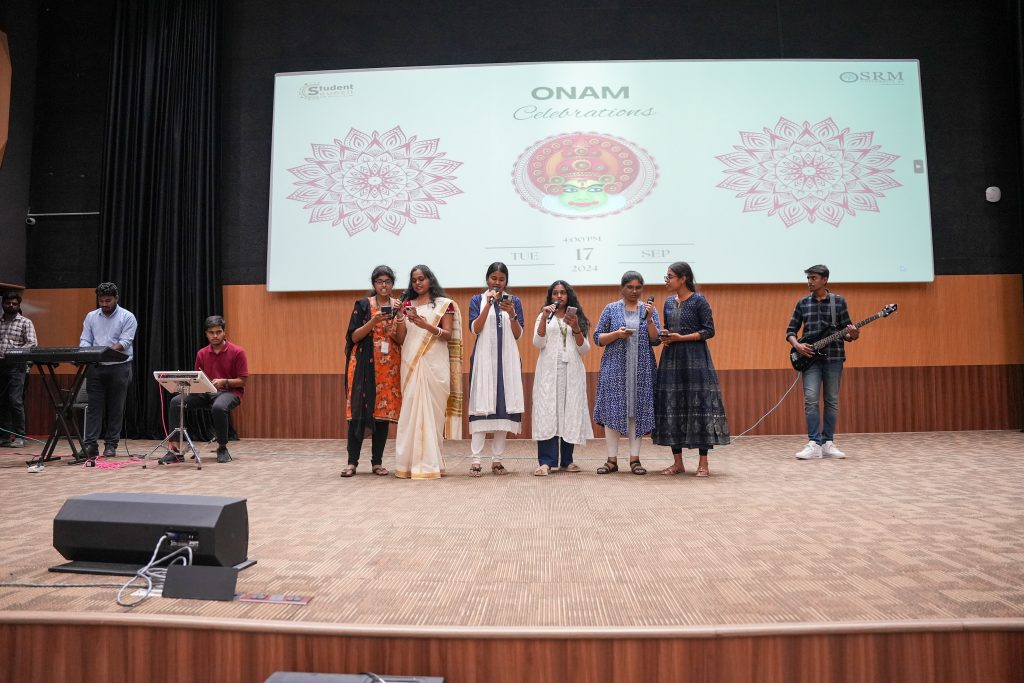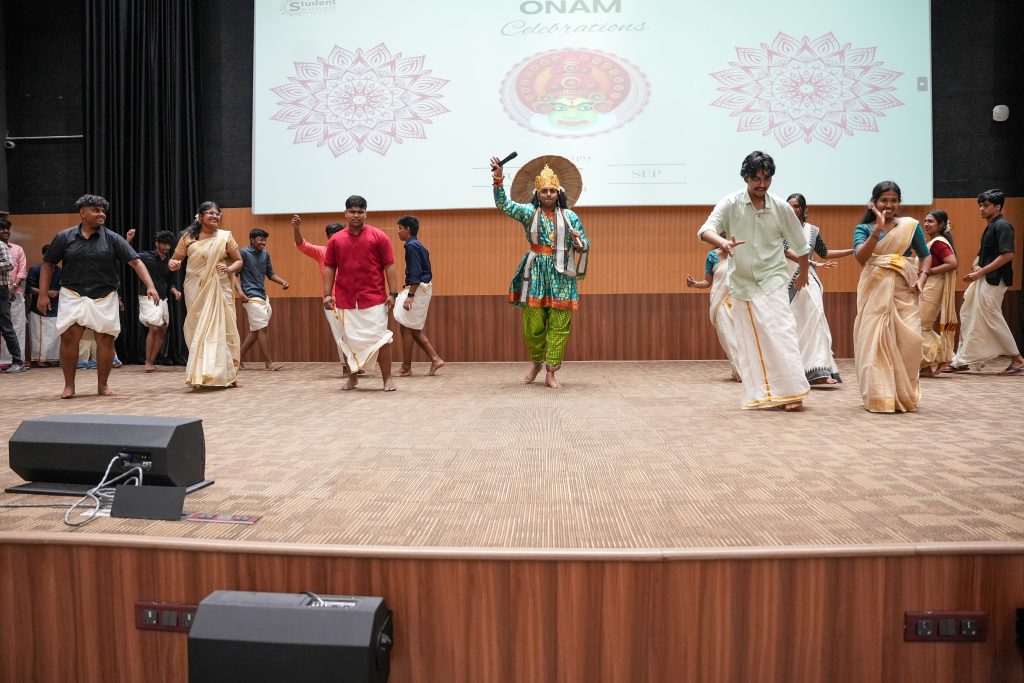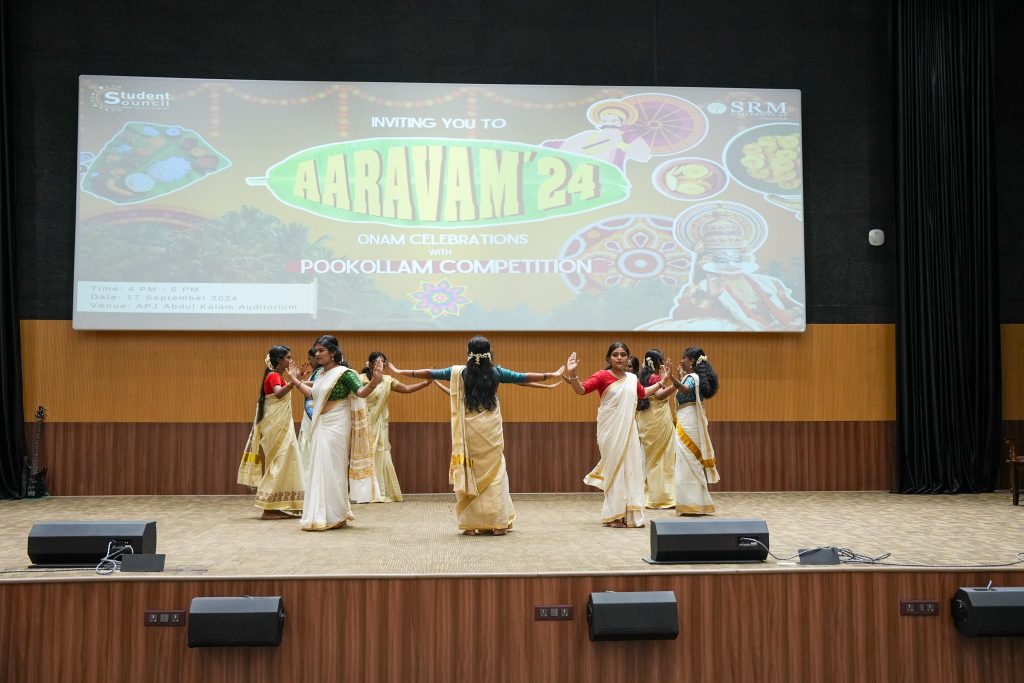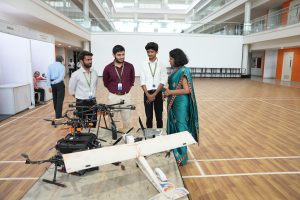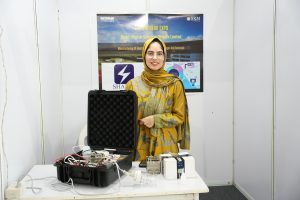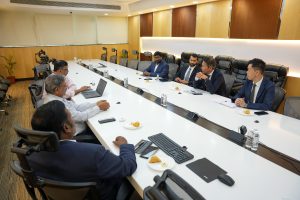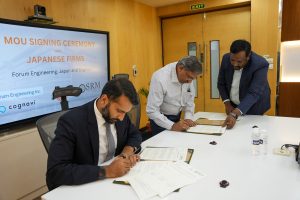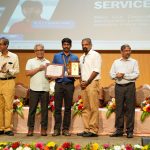AARAVAM 2024 Concludes with a Bang!
 Unity in diversity is more than just a saying at SRM University-AP; it’s the heart and soul of our campus. With over 6000+ students from various states and union territories and an international diversity representing 24 countries each festival serves as a bridge, drawing a closer bond amongst all. The Onam celebration, Aaravam 2024, on campus was no different, the varsity celebrated Onam on September 17, 2024.
Unity in diversity is more than just a saying at SRM University-AP; it’s the heart and soul of our campus. With over 6000+ students from various states and union territories and an international diversity representing 24 countries each festival serves as a bridge, drawing a closer bond amongst all. The Onam celebration, Aaravam 2024, on campus was no different, the varsity celebrated Onam on September 17, 2024.
The celebration orchestrated by the Directorate of Student Affairs oversaw the decoration and resplendent showcase of the Kerala culture through dance and music. The festivities commenced with the traditional Thiruvathirakali, a dance that saw students gracefully attired in the Kerala Kasavu saree, enhancing the aesthetic appeal of the day, followed by an array of cultural performances that captivated the audience. The highlight of the celebration was the appetising Onam payasam, which brought in the sweetness of the festival itself.
The appearance of King Mahabali brought a wave of joy among us all. In a heartwarming gesture, our Kerala community shared a captivating video that told the story of Onam, welcoming everyone to partake in the tradition, truly reflecting SRM AP‘s embrace of diverse cultures.
The event was graced by the presence of Registrar Dr R Premkumar, the Deans of the three schools, and King Mahabali himself, along with our faculty, staff and students. It was a day that drew us all closer, celebrating Kerala’s rich cultural tapestry. More than just a celebration, it was a reminder of the beauty in our diversity and the strength in our unity.
- Published in Departmental News, News, student affairs news
Techpreneur Expo-2024: A Grand Showcase of Innovation and Technology
 In a significant step forward for innovation and entrepreneurship, the Directorate of Entrepreneurship and Innovation recently organised the highly anticipated Techpreneur Expo-2024. The event, held at SRM University-AP, attracted a host of distinguished guests, including Dr Krish Gopalakrishnan, Co-Founder of Infosys; Mr Rohit Kapoor, CEO of Swiggy; Pro-Chancellor of SRM University-AP, Dr P Sathyanarayanan; Vice Chancellor Prof. Manoj Arora; and Registrar Dr R Premkumar, who lent their support and expertise to this integral gathering.
In a significant step forward for innovation and entrepreneurship, the Directorate of Entrepreneurship and Innovation recently organised the highly anticipated Techpreneur Expo-2024. The event, held at SRM University-AP, attracted a host of distinguished guests, including Dr Krish Gopalakrishnan, Co-Founder of Infosys; Mr Rohit Kapoor, CEO of Swiggy; Pro-Chancellor of SRM University-AP, Dr P Sathyanarayanan; Vice Chancellor Prof. Manoj Arora; and Registrar Dr R Premkumar, who lent their support and expertise to this integral gathering.
The Techpreneur Expo served as a vibrant technical showcase featuring 25 stalls presented by the Department of Next Tech Lab, the Directorate of Entrepreneurship and Innovation, and the Department of Research. Attendees were treated to an impressive array of cutting-edge technologies and projects, ranging from Additive Manufacturing and Bio-Printing to advancements in Robotics and Piezoceramics. Noteworthy projects included Unmanned Aerial Vehicles, IoT applications in Drone Technology, and pioneering RF Frontend Designs for 6G Applications. Environmental sustainability was emphasised through displays on Flexible Solid-State Electrolytes for eco-friendly lithium-ion batteries and the Responsible Management of Electronic Waste, along with initiatives for the Reclamation of Critical Metals aimed at fostering Sustainable Development.
In addition to these advanced technologies, the expo presented innovative projects such as Rechargeable Batteries, Smart Indoor Localization, and Edge AI. Guests and participants had the opportunity to explore the Thermal Management of Electronic Components, Hydrogen Fuel Cells, and Waste Valorization projects that advocate for sustainability. Cutting-edge companies, including SYNC-HAB, SecEn Semiconductors & Test Solutions, and Shakti Photon Solutions Private Limited, showcased their contributions to technology solutions. Moreover, unique offerings like Smart Automation and Self-Optimised Clean Energy Systems, No Wait (a smart solution for lift management), and AI-driven initiatives like ResuMatch for resume mock interviews and AdamantiumRE for malware analysis highlighted the inventive spirit of the event.
Throughout the expo, the esteemed guests visited each stall, commending the quality of the displays and the depth of innovation demonstrated by the students. The event proved to be a resounding success, providing invaluable insights and learning opportunities for students while fostering an atmosphere of collaboration and entrepreneurial spirit within the tech community.
The Techpreneur Expo-2024 not only spotlighted the remarkable talents of budding entrepreneurs and innovators but also set the stage for future advancements in technology, signalling a bright horizon for entrepreneurship and innovation in the region.
- Published in CR&CS Webinars, Departmental News, IDEA NEWS, Innovation, News
SRM AP Forges Partnership for Pavement Engineering

In a historic event, SRM University-AP and the Department of Road and Buildings (R&B), Government of Andhra Pradesh, signed a Memorandum of Understanding. The MoU was signed for Research, Academic and Scientific Knowledge Exchange in the field of Pavement Engineering and its allied areas.
The signing ceremony was formally executed by Dr R Premkumar, Registrar of SRM University-AP, and Sri L Srinivasa Reddy, Chief Engineer (Roads & Buildings) SH&MD, Andhra Pradesh Road Development Corporation. This significant event was witnessed by Mr K Nayeemullah, the Engineer-in-Chief (Roads & Buildings), alongside Prof. Ranjit Thapa, the Dean of Research; Dr Raviteja KVNS, the Department Head; Dr GVP Bhagat Singh, Associate Professor; Dr Uma Maheswar Arepalli, Assistant Professor; and other distinguished members of the faculty.
The collaboration poised to enhance bilateral engagement in research, pilot initiatives, and capacity-building efforts, will also foster student upskilling and reskilling through seminars, workshops, symposia, guest lectures, and co-mentorship in academic endeavours and enable them to perform better on the industrial front.
Speaking on the occasion, Registrar Dr R Premkumar stated, “This MoU serves one of the university’s goals, wherein we concentrate on positioning the university as a globally connected and regionally transformative institution of excellence.” He added that nobody is better suited than the faculty and students of SRM AP to come up with effective and affordable solutions to the problems we ourselves encounter.
“The MoU offers manifold benefits, it will enable government engineers to come and train the students and will provide them with first-hand experience in solving problems that are regional to this place”, said Mr K Nayeemullah, Engineer-in-Chief (R&B).
Dr Uma Maheswar Arepalli, Assistant Professor at the Department of Civil Engineering, SRM AP, in his statement, mentioned that the university is actively engaged in implementing the pilot study programme focused on researching cost-effective technology solutions aimed at addressing the issue of potholes across the state of Andhra Pradesh. He further stated that their team is in the process of organising a workshop aimed at raising awareness and fostering discussions on innovative approaches to infrastructure maintenance and improvement.
The MoU also aims to complement the varsity in its research endeavours by performing pilot studies and exploring new technologies including laboratory and field investigations. “The MoU will help actualise the concept of Atmanirbhar Bharat, which will only succeed if universities like SRM AP commit to providing cost-effective and real-time solutions for the betterment of society,” stated Mr Srinivasa Reddy, Chief Engineer (R&B) SH & MD APRDC.
- Published in CIVIL NEWS, Departmental News, MoU, News
SRM AP Signs MOU with Forum Engineering Inc. and Cognavi India Private Limited
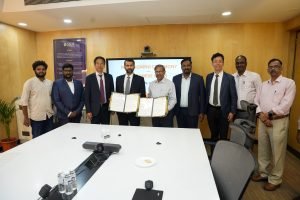 In a landmark move towards enhancing global educational opportunities, SRM University-AP has entered into a Memorandum of Understanding (MOU) with Japan’s Forum Engineering Inc. and Cognavi India Private Limited. The agreement aims to foster collaboration in providing students with career opportunities in Japan’s thriving engineering sector.
In a landmark move towards enhancing global educational opportunities, SRM University-AP has entered into a Memorandum of Understanding (MOU) with Japan’s Forum Engineering Inc. and Cognavi India Private Limited. The agreement aims to foster collaboration in providing students with career opportunities in Japan’s thriving engineering sector.
The signing ceremony, which took place at the SRM University-AP campus, brought together key representatives from all three parties. The MOU outlines a comprehensive operational framework, detailing the roles and expectations of each participant, and sets a clear roadmap for successful partnership.
As per the agreement, SRM University-AP will be responsible for identifying and providing the names and qualifications of students eligible for employment opportunities in Japan. This initiative marks a significant step in promoting international career pathways for students, particularly in engineering fields. Cognavi India will act as an intermediary, facilitating communication between SRM University-AP and Forum Engineering Inc., which will ultimately be responsible for hiring and selecting candidates for positions within its organisation.
“The collaboration with Forum Engineering Inc. and Cognavi India reflects our commitment to expanding our educational impact and providing our students with global career opportunities,” said Dr MS Vivekanandan, Director of Corporate Relations and Career Services, SRM University-AP. “We are excited about the potential of this partnership to transform the lives of our students.”
Forum Engineering Inc., based in Tokyo, is a well-established entity in the engineering sector, known for its innovative solutions and skilled workforce. The company expressed enthusiasm about the collaboration, emphasising its dedication to attracting talented graduates from SRM University-AP.
Through this partnership, we aim to bridge the gap between education and industry, creating pathways for talented individuals from India to thrive in Japan’s dynamic work environment.
Cognavi India, playing a crucial role in this partnership, will ensure that the processes of recruitment and selection are streamlined and effective, guaranteeing that both students and the partnering companies benefit from this initiative.
The MOU signifies a progressive step forward in enhancing educational collaborations between India and Japan, as well as reinforcing SRM University-AP’s position as a leading educational institution committed to student success on a global scale.
This agreement not only paves the way for students to gain valuable international experience but also fosters cultural exchanges that can lead to broader professional networks and opportunities in the future.






- Published in CR&CS NEWS, Departmental News, News
SMAFS Technology Gets Patented

Dr Anirban Ghosh and his BTech students, Mr Taraka Sai Tanishq Chebrolu and Mr V.M.V.S. Aditya from his department, have come up with a pathbreaking innovation where a Smart Face Shield (SMAFS) helps detect a virus and reminds the wearer to maintain a safe distance. This innovation, patented under the Indian Patent Office Journal, with application number-202241000990 , marks a milestone step towards public health and safety.
Abstract:
The recent spurt of corona virus has wreaked havoc across the globe and led to huge loss of human lives. An intelligent system with innovative technologies can be implemented to address the rapid spread of the deadly virus. The wearable face shield that can not only help to maintain appropriate social distancing in a crowded place but also to identify a person with preliminary symptoms of corona virus. It is designed as a technically improved face shield to maintain social distancing by appropriate use of proximity sensor and to measure temperature of the wearer by using contact temperature sensor. LED’s and buzzer are placed strategically to alert people via visual and audio signals respectively. Such precautionary detection and proximity alert prototype can prove instrumental in early diagnosis and isolation aiding in crowd management and free movement in places of social gathering.
Practical Implementation of the Patent:
Such precautionary detection and proximity alert prototype can prove instrumental in early diagnosis and isolation aiding in crowd management and free movement in places of social gathering. Hence, wearable face shield ensures adequate separation between persons and facilitates temperature monitoring and early disease detection.
Future Research Plans:
Future research plans are to further improve the capability of the existing prototype for example integration of oxygen saturation measurement, Heartbeat, Blood pleasure, Temperature, Location, etc of the user. In the event of an emergency or critical drop in any of the vitals, the system can automatically alert the local hospital, ambulance service, and relatives.

- Published in CSE NEWS, Departmental News, ECE NEWS, News, Research News
SRM University-AP Honoured Faculty for their Exemplary Excellence in the Field of Education
 SRM University-AP, renowned for its commitment to academic excellence and holistic development, celebrated Teachers’ Day jointly organised by the Directorate of Human Resources & Development and the Directorate of Student Affairs with a heartful tribute to its dedicated faculty members. The event was a testament to the profound impact that teachers have on their student’s lives, shaping not only their academic journeys but also their personal and professional growth.
SRM University-AP, renowned for its commitment to academic excellence and holistic development, celebrated Teachers’ Day jointly organised by the Directorate of Human Resources & Development and the Directorate of Student Affairs with a heartful tribute to its dedicated faculty members. The event was a testament to the profound impact that teachers have on their student’s lives, shaping not only their academic journeys but also their personal and professional growth.
The event was celebrated in the presence of Prof. V S Rao, Advisor; Dr R Premkumar, Registrar, SRM University-AP; Deans; directors; faculty members; and students. It was a collaborative effort by students and staff, who joined hands to pay respectful tribute to the faculty’s exemplary service. The Chief Guest for the event, Prof Devang V Khakhar, Former Director of IIT Bombay, graced the occasion virtually.
During the occasion, Prof V S Rao, Advisor to SRM University-AP, added his words of appreciation, stating, “Teachers are the architects of tomorrow’s world. Their dedication, passion, and commitment inspire and empower the students to reach their full potential. Our faculty members are transitioning from traditional teaching roles to becoming mentors and facilitators.”
In his speech, Chief Guest Prof. Devang V Khakhar underscored the pivotal role of faculty in a university’s success. He stated, “The strength of an academic institution lies in its teachers. They shape the future by enhancing students’ learning capabilities and skills. Indeed, teachers are the true pillars of any academic institution.”
The event also marked the announcement of the Outstanding Faculty Awards, honouring Dr Sunil Chinnadurai, Associate Professor, Department of ECE; Dr Lakshmi Sirisha Maganti, Assistant Professor, Department of Mechanical Engineering; Dr Karthikeyan E, Assistant Professor, Department of ECE; Dr Mahesh Kumar M, Assistant Professor, Department of CSE; Dr Satish Anamalamudi, Associate Professor, Department of CSE; Dr Sabyasachi Chakrabortty, Associate Professor, Department of Chemistry; Dr Rajapandiyan Panneerselvam, Assistant Professor, Department of Chemistry; Dr Vimal Babu – Associate professor, Department of Management; Dr Lakshmana Rao Ayyangari, Associate professor, Department of Commerce for their exceptional contributions to their respective departments. Dr Sutharsan Govindarajan, Assistant Professor in the Department of Biological Sciences, was bestowed with the “Prof. V S Rao Foundation – Prof. HP Tiwari Best Faculty Award“.
The awardees expressed their gratitude to the university and students in their acceptance speeches.
The ceremony also recognised the dedication of faculty members with the Five-Year Services Award. The celebration was moderated by Prof. Sheela Singh, Associate Director of Faculty Affairs, who provided insightful commentary and ensured a smooth flow of events. The celebration concluded with a series of captivating performances by students, showcasing their talents and appreciation for their teachers. The Students Council presented the token of gifts to select adorable teachers. The event was a memorable occasion that highlighted the strong bond between students and faculty at SRM University-AP.
- Published in Departmental News, News, student affairs news
SRM AP’s Hatchlab Research Centre Selected as Implementation Agency for GENESIS Scheme
 The Directorate of Entrepreneurship and Innovation is thrilled to announce that the Hatchlab Research Centre (HRC), the Technology Business Incubator at SRM University-AP, has been chosen as the Implementation Agency for the “Gen-Next Support for Innovative Startups (GENESIS)” initiative. This decision, made by the Ministry of Electronics & Information Technology (MeitY), Government of India, marks a significant milestone for HRC and highlights its commitment to fostering innovation and entrepreneurship.
The Directorate of Entrepreneurship and Innovation is thrilled to announce that the Hatchlab Research Centre (HRC), the Technology Business Incubator at SRM University-AP, has been chosen as the Implementation Agency for the “Gen-Next Support for Innovative Startups (GENESIS)” initiative. This decision, made by the Ministry of Electronics & Information Technology (MeitY), Government of India, marks a significant milestone for HRC and highlights its commitment to fostering innovation and entrepreneurship.
The GENESIS scheme emerges as a strategic umbrella initiative by MeitY aimed at nurturing and supporting startup ecosystems in Tier II and Tier III cities across India. HRC is among the 50 selected implementation agencies tasked with facilitating this vision, backed by a total budgetary allocation of ₹490 crores. This funding will be instrumental in providing vital resources and infrastructure for startups, ensuring they have the necessary support to thrive in a competitive landscape.
Prof. Sidharth Shankar Tripathy, Director of Entrepreneurship & Innovation of SRM AP, said, ” This announcement is a tribute to the soaring entrepreneurial spirit that is visible among the students, faculty and even the staff of our young entrepreneurial university. What makes this achievement even more special is that it was announced at an appropriate juncture time when SRM University-AP had declared the academic year 2023-24 as the “Year of Entrepreneurship & Innovation.With this new responsibility, we look forward to contributing to the success of startups and innovators across India!”
The HRC’s selection comes at a fortuitous time, as SRM University-AP has declared the 2023-24 academic year to be the “Year of Entrepreneurship & Innovation.” This initiative aims to foster a culture of creativity and entrepreneurial spirit among students, providing them with the tools and support needed to transform their ideas into viable business ventures.
The GENESIS scheme is designed to enhance the startup ecosystem in smaller cities, enabling entrepreneurs outside of metropolitan areas to access essential services, mentorship, and funding opportunities. By selecting HRC as an implementation partner, MeitY acknowledges the centre’s potential to drive impactful change and support innovative startups in the region.
As HRC embarks on this new journey, it promises to create a robust framework that encourages collaboration, knowledge sharing, and the development of sustainable business models among emerging entrepreneurs. The centre will facilitate various programs, workshops, and resources designed to equip startups with the skills, network, and funding requisite for success.
With this prestigious recognition, SRM University-AP’s Hatchlab Research Centre is poised to play a pivotal role in transforming the entrepreneurial landscape, paving the way for a more inclusive and diverse startup ecosystem across the nation.
- Published in Departmental News, IDEA Events, IDEA NEWS, Innovation, News
From Concept to Reality: The Promising Future of AlN-GDC-HEMT in Electronics

The Department of Electronics and Communication Engineering, SRM University-AP, is pleased to announce that Assistant Professor Dr Durga Prakash has published a noteworthy research paper titled “A Novel LG=40 nm AlN-GDC-HEMT on SiC Wafer with fT/IDS,peak of 400 GHz/3.18 mA/mm for Future RF Power Amplifiers.” This accomplishment reflects Dr Durga Prakash’s expertise and dedication to advancing research in the field and further enriching the academic contributions of the varsity.
Abstract:
This study presents the initial RF/DC performance of innovative AlN/GaN/Graded-AlGaN/GaN double-channel HEMT (AlN-GDC-HEMT) on SiC wafer. Traditional AlGaN/GaN/Graded-AlGaN/GaN double-channel HEMTs (AlGaN-GDC-HEMT) and the AlN-GDC-HEMT are compared. Both devices form two quantum wells, resulting in prominent double peaks in transconductance and cut-off frequency graphs, demonstrating efficient inter-channel communication. AlN-GDC-HEMT and AlGaN-GDC-HEMT are compared based on gate recess length (LR) and top barrier thickness. Gate lengths (LG) are also used to study HEMT scaling. Additionally, gate engineering and lateral scaling affect both devices’ DC/RF behaviour. Based on rigorous comparison investigation, the AlN-GDC-HEMT outperforms the AlGaN-GDC-HEMT due to its higher polarization (spontaneous) density and larger bandgap. The optimized AlN-GDC-HEMT with LG = 40 nm, LGS = 250 nm, and LGD = 400 nm has high performance, with transconductance (GM) values of 203.1 and 787.5 mS/mm at two peaks, IDS_peak of 1.97 A/mm, IDS_sat of 3.18 A/mm, and the highest fT of 285.1 and 416.8 GHz from the left and right peaks First-stage results suggest AlN-GDC-HEMTs could be used in future RF power amplifiers.
Practical & Social Implications of the Research:
It can be concluded that the AlN-GDC-HEMT that has been proposed is extremely promising, as it possesses remarkable performance and is appealing for power microwave GaN-based HEMT production. This highlights the fact that it is suitable for a broad variety of high-performance applications.
Collaborations:
Department of ECE, Faculty of Science and Technology (IcfaiTech), ICFAI Foundation for Higher Education Hyderabad, Hyderabad-501203, India.
Future Research Plans:
Novel semiconductor device development

- Published in Departmental News, ECE NEWS, News, Research News
Dr Barman Decodes the Mysteries of the Universe

Ever wondered how the universe came into existence? The component with which matter and antimatter were formed? Dr Basabendu Barman, Assistant Professor at the Department of Physics, in his research paper, titled- Leptogenesis, Primordial Gravitational Waves, and PBH-induced Reheating delves into the truth of the formation of matter. Read this exciting paper featured in Physics Review D to learn more!
Abstract:
We explore the possibility of producing the observed matter-antimatter asymmetry of the Universe uniquely from the evaporation of primordial black holes (PBH) that are formed in an inflaton-dominated background. We show it is possible to obtain the desired baryon asymmetry via vanilla leptogenesis from evaporating PBHs of initial mass around 10g. We find that the allowed parameter space is heavily dependent on the shape of the inflaton potential during reheating, the energy density of PBHs, and the nature of the coupling between the inflaton and the Standard Model (SM). To complete the minimal gravitational framework, we also include in our analysis the gravitational leptogenesis set-up through inflaton scattering via exchange of graviton, which opens up an even larger window for PBH mass, depending on the background equation of state. We finally illustrate that such gravitational leptogenesis scenarios can be tested with upcoming gravitational wave (GW) detectors, courtesy of the blue-tilted primordial GW with inflationary origin, thus paving a way to probe a PBH-induced reheating together with leptogenesis.
Practical Implementations & Social Impact:
The first implication lies in the realm of intellect. The question, “Why is the Universe the way it is?” is profoundly significant and has likely intrigued humanity since the dawn of civilization. While technological advancements have allowed us to unravel many of the Universe’s mysteries, we have also come to realize that “what we know is a drop, and what we don’t know is an ocean.” As theoretical particle physicists, our role is to explore this vast ocean of the unknown—a pursuit for which we are rigorously trained. This underscores the vital importance of studying fundamental science. From a practical perspective, our study highlights the crucial role that experiments play in uncovering new knowledge. The synergy between theory and experiment, as we propose, could soon lead to groundbreaking discoveries—or, alternatively, our theory could be disproven if no evidence is found. Either way, it is essential to have advanced experimental facilities and more sensitive detectors to carry out these investigations. This, in turn, calls for increased funding and support for research in the field of high-energy physics.
Collaborations:
India (IIT: Guwahati, Kanpur, Hyderabad; IACS, Kolkata; IOP, Bhubaneswar).
Colombia (Universidad de Antioquia, Universidad de Santiago de Chile).
Abu Dhabi (New York University, Abu Dhabi).
Brazil (IIP, Natal).
Germany (Mainz Institute for Theoretical Physics [MITP], Mainz).
Poland (University of Warsaw).
Spain (Universidad Complutense,Madrid; IFIC, Valencia).
China (T D Lee Institute).
Korea (IBS, Daejeon; KIAS, Seoul; Kyungpook National University, Daegu).
Japan (Hokkaido Univeristy).
France (IJC Lab, Paris).
Sweden (KTH, Stockholm)
US (Washington University, St. Louis; University of Minnesota; Indiana University; University of Pittsburgh, University of Kentucky).
Future Plans:
A closer look into early universe dynamics by performing more involved simulations.Connection between particle physics models and early Universe cosmology.Complementary searches from different experiments in unravelling new physics beyond the Standard Model.
Link: https://journals.aps.org/prd/abstract/10.1103/PhysRevD.110.043528

- Published in Departmental News, News, Research News
Dr Rupesh Kumar Secures Major Research Grant for Amazon Forest Canopy Mapping Project
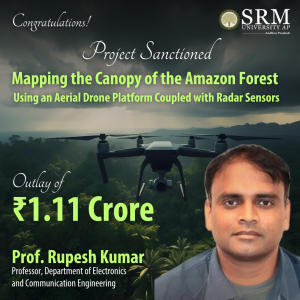 In a groundbreaking development, Dr Rupesh Kumar, a Professor in the Department of Electronics and Communication Engineering, has been awarded a significant project titled “Mapping the Canopy of the Amazon Forest Using an Aerial Drone Platform Coupled with Radar Sensors.” The initiative, funded by the International Peruvian National Research Institute, boasts an impressive outlay of Rs. 1.11 Crores and is set to span over a two-year period.
In a groundbreaking development, Dr Rupesh Kumar, a Professor in the Department of Electronics and Communication Engineering, has been awarded a significant project titled “Mapping the Canopy of the Amazon Forest Using an Aerial Drone Platform Coupled with Radar Sensors.” The initiative, funded by the International Peruvian National Research Institute, boasts an impressive outlay of Rs. 1.11 Crores and is set to span over a two-year period.
The project is spearheaded by Principal Investigator Dr Mark Donny Clemente Arenas, an Associate Professor at the National Technological University of South Lima in Peru. This collaboration aims to enhance the understanding of the Amazon’s intricate canopy structure and promote conservation efforts through innovative technology.
In recognition of this notable achievement, SRM University-AP proudly congratulated Dr Kumar and highlighted the significant impact this project could have on environmental research and sustainability. The university’s support underscores its commitment to fostering research initiatives that address global challenges, encouraging faculty members to pursue innovative solutions through collaboration and the application of cutting-edge technology.
This initiative marks a significant milestone in international research collaboration, leveraging technology to address critical environmental challenges in one of the world’s most vital ecosystems.
A Brief Description of the Project
This project facilitates the mapping of the Amazon forest in Peru. An integrated approach of advanced sensors such as LiDAR, Millimeter-Wave Radar, Camera, etc. and UAV will achieve this.
This will help assess the Amazon forest’s health in real time by leveraging the ML/AI approaches.

Figure 1: Scheme for height estimation
Explanation of the Research in Layperson’s Terms
The plant/tree generally reflects radio waves and other signals, and this reflection depends on the density of the forest. If a suitable signal processing is applied to the reflected signals, it will provide insight information about the forest profile. Nevertheless, this will help in the quantification of land covered by trees, identifying the location of those trees. Consequently, the tree canopy assessments help in determining the amount and location of impervious cover.
Funding Agency and Amount Sanctioned
National Scientific Research and Advanced Studies Program (PROCIENCIA) of the National Council for Science, Technology and Technological Innovation (CONCYTEC), Peru.
In Spanish: “ Programa Nacional de Investigación Cientifica y Estudios Avanzados (PROCIENCIA), del Consejo Nacional de Ciencia, Tecnología e Innovación
Tecnológica (CONCYTEC), Perú”.
Practical Implementation of the Research or the Social Implications Associated with it
The proposed research work help will help in the assessment of deforestation as well as its impact on climate change and global warming. Not only this, but the research will also contribute to achieving carbon neutrality by 2050!
Collaborations
Universidad Nacional Tecnológica de Lima Sur
Collaborator: Prof. Mark Clement Arenas
Future Research Plans
In future, this work will be extended for infrastructure monitoring. With the boom in real estate, a continuous monitoring system is desired for proper maintenance.
- Published in Departmental News, ECE NEWS, News, Research News





